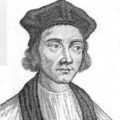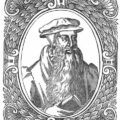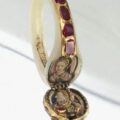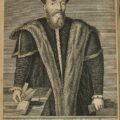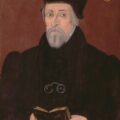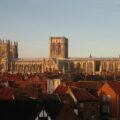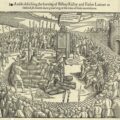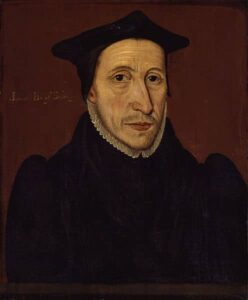
Bishop John Jewel was born on the 24th May 1522 in Buden, North Devon, one of ten children. He was educated by his maternal uncle, John Bellamy, Rector of Hampton, because he showed signs of intelligence. He was a hardworking, conscientious and studious boy, and went on to study at Merton College, Oxford, where he studied under John Pankhurst (later the Bishop of Norwich), the man credited with introducing Jewel to reformist doctrines. In August 1539, Jewel transferred to Oxford’s Corpus Christi College, from which he graduated with a Bachelor of Arts in 1540, followed by a Masters in 1545 after being elected as a fellow in 1542. John and Angela Magee1 tell of how Jewel was “considered as a decided and open friend to the Protestant cause” (citing Charles Webb Le Bas, M.A.) and that proof of this is the fact that he received an annual payment of six pounds from a special fund collected by the nobility for the purpose of supporting scholars who professed Reformist doctrines.
In 1549, Jewel met Peter Martyr (Pietro Martire Vermigli), who had come to Oxford as a lecturer. The men became great friends, with Jewel seeing Martyr as a father figure. After attaining his Bachelor of Divinity in 1552, Jewel became vicar of Sunningwell in Berkshire and also acted as a public orator at the university. It was in his job as orator that he had to compose an epistle to congratulate Mary I on her accession in 1553. Mary I’s accession brought to an end the Protestant reforms of Edward VI’s reign and brought trouble for Jewel. His college expelled him for not attending the Mass, for preaching heresy and for his friendship with Peter Martyr. In 1554, he acted a notary at the disputation of Thomas Cranmer and Nicholas Ridley, but then, fearing for his life, went on to sign a series of Catholic articles. However, he was still living under suspicion and so fled to the Continent, to Frankfurt.
In Frankfurt, Jewel did not exactly receive a warm welcome from John Knox and William Whittingham, after all, he had signed those Catholic articles. He also sided with Richard Cox and the “Coxians” against Knox and Whittingham. Cox stood up for the Prayer Book of 1552 service and the teachings of Cranmer, whereas Knox and Whittingham wanted a far more puritanical service and followed the doctrines of Calvin. Jewel them made a public confession to atone for his previous weakness in signing the Catholic articles, but the growing divisions between the Coxians and Knoxians led to him leaving Frankfurt and joining his good friend, Peter Martyr in Strasbourg. The two men then travelled to Zurich and also Padua.
In November 1558, the Catholic Mary I died and Elizabeth I became Queen of England. All of the Protestant exiles knew that it was now safe to return to England and John Jewel returned home. In 1559, he confuted the Catholics at the conference held at Westminster after Easter and John and Angela Magee2 tell of how Jewel preached a rousing sermon at St Paul’s Cross in November1559 based on 1 Corinthians 11 verse 23: “For I have received of the Lord that which also I delivered unto you, that the Lord Jesus the same night in which he was betrayed took bread…” in which he outlined 27 doctrines held by the Catholic Church and offered to return to the Catholic Church if anyone could prove the practice of these doctrines in the first 600 years after Christ’s death. When he repeated this challenge in 1560, it was taken up by Henry Cole, former Provost of Eton College, and this resulted in Cole being imprisoned in the Tower and Jewel writing his Apologia ecclesiae Anglicanae (Apology of the Church of England”, which was published in 1562 and which is “considered by some to form the groundwork for all subsequent controversy the Church of England would have with the Church of Rome.”3
On the 21st January 1560, Jewel was consecrated as Bishop of Salisbury, a diocese which was impoverished as a result of Jewel’s predecessor, John Capon (or Salcot), abusing his role. Jewel set about turning things around and also encouraged men who showed promise to teach in the church. He was the patron of Anglican priest and theologian Richard Hooker who described Jewel as being the “worthiest divine Christendom hath bred for the space of some hundreds of years.”4
In the 1560s a literary and theological battle sprang up between Jewel and Thomas Harding, a man Jewel had known at Oxford and a man he had also ejected from his post in Salisbury Cathedral. Harding had been of Protestant views during the reign of Edward VI but had returned to Catholicism in Mary I’s reign, becoming Bishop Gardiner’s confessor and also canon-in-residence and treasurer of Salisbury Cathedral. In 1564, Harding published his “Answer” which was followed in 1565 by Jewel’s “Reply”, then Harding’s 1566 “Confutation” and Jewel’s 1567 “Defence of the Apology”.
In 1571, John Jewel was taken ill while preaching a sermon in Lacock and Wiltshire and died on the 23rd September at Monkton Farleigh Manor. He was laid to rest in Salisbury Cathedral.
In 1609, during the reign of James I, the Archbishop of Canterbury, Richard Bancroft, published Jewel’s works in folio and ordered Jewel’s greatest work, his “Apology” (Apologia ecclesiae Anglicanae), to be placed in churches throughout England. The Magees explain that his Apology is divided into six sections:-
“Section one addresses the attacks made against Protestantism in Jewel’s day.
Section two expounds Protestant doctrine.
Section three makes the bold claim that the Protestant churches are in the true line of succession from the early Church Fathers.
Section four exposes the scandals of the Church of Rome and the errors into which it had plunged.
Section five discredits the claims of Rome to have the support of the Church Fathers.
Section six shows the impossibility of accepting the judgments of the Council of Trent.”5
And Wikipedia describes it as “an attempt to provide a statement of faith for the Church of England under Elizabeth I and answer challenges and accusations of the Romanists against the Protestants.”6
Notes and Sources
- Bishop John Jewel (1522-1571) – An article by John and Angela Magee from the Emmanuel Church Salisbury website.
- Ibid.
- Ibid.
- Ibid.
- Ibid.
- John Jewel – Wikipedia page
